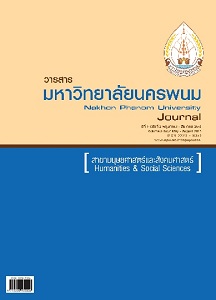การพัฒนารูปแบบการจัดการเรียนรู้วิทยาศาสตร์เพื่อส่งเสริมการคิดอย่างมีวิจารณญาณของนักเรียนชั้นมัธยมศึกษาตอนปลาย
Main Article Content
Abstract
การวิจัยครั้งนี้มีจุดประสงค์เพื่อ1)ศึกษาและวิเคราะห์องค์ประกอบการคิดอย่างมีวิจารณญาณของนักเรียนชั้นมัธยมศึกษาตอนปลาย 2)พัฒนารูปแบบการจัดการเรียนรู้วิทยาศาสตร์เพื่อส่งเสริมการคิดอย่างมีวิจารณญาณ และ3)ศึกษาผลการใช้รูปแบบการจัดการเรียนรู้ โดยดำเนินการวิจัย 3ระยะ คือ ระยะที1ศึกษาและวิเคราะห์องค์ประกอบการคิดอย่างมีวิจารณญาณ โดยการสัมภาษณ์เชิงลึกผู้ทรงคุณวุฒิ จำนวน 5 คน และยืนยันองค์ประกอบการคิดอย่างมีวิจารณญาณกับข้อมูลเชิงประจักษ์จาก กลุ่มตัวอย่างที่เป็นตัวแทนของนักเรียนทั่วประเทศ จำนวน 600คน ใช้สถิติการวิเคราะห์องค์ประกอบเชิงยืนยันด้วยเทคนิควิเคราะห์โมเดลสมการโครงสร้าง ระยะที่ 2พัฒนารูปแบบการจัดการเรียนรู้เพื่อส่งเสริมการคิดอย่างมีวิจารณญาณ โดยการสัมภาษณ์เชิงลึกผู้ทรงคุณวุฒิ จำนวน 5 คน ระยะที่ 3 ศึกษาผลการใช้รูปแบบการจัดการเรียนรู้ที่ผู้วิจัยได้พัฒนาขึ้น โดยกลุ่มตัวอย่างเป็นนักเรียนชั้นมัธยมศึกษาปีที่ 5โรงเรียนบดินทรเดชา (สิงห์ สิงหเสนี) จำนวน 2 ห้อง ได้มาโดยการสุ่มแบบกลุ่ม โดยกลุ่มควบคุมได้รับการจัดการเรียนรู้ตามคู่มือครูแบบ 5E กลุ่มทดลองใช้รูปแบบการจัดการเรียนรู้วิทยาศาสตร์เพื่อส่งเสริมการคิดอย่างมีวิจารณญาณ เครื่องมือที่ใช้ในการวิจัยคือแผนการจัดการเรียนรู้ แบบวัดความสามารถ ในการคิดอย่างมีวิจารณญาณ และแบบทดสอบผลสัมฤทธิ์ทางการเรียน สถิติที่ใช้ในการวิเคราะห์ข้อมูล ได้แก่ ค่าเฉลี่ย ส่วนเบี่ยงเบนมาตรฐาน ทดสอบสมมติฐานด้วยสถิติการวิเคราะห์ความแปรปรวนเชิงพหุแบบวัดซ้ำ
ผลการวิจัยพบว่า 1)องค์ประกอบการคิดอย่างมีวิจารณญาณมี 4องค์ประกอบคือการกำหนดความชัดเจนของปัญหา การแสวงหาแนวทางในการตอบปัญหา การวิเคราะห์อย่างมีเหตุผล และการลงข้อสรุปและตัดสินใจ 2)รูปแบบการจัดการเรียนรู้มีหลักการ สำคัญคือเป็นรูปแบบที่เน้นกิจกรรมการเรียนรู้ 5 ขั้น ได้แก่ ขั้นสร้างแรงจูงใจ ขั้นให้ข้อมูลสู่ประเด็นสำคัญ ขั้นร่วมกันสืบเสาะค้นหาขั้นพิจารณาไตร่ตรองและขั้นมองเห็นการค้นพบ ซึ่งเรียกว่า M4D Learning Method 3) เมื่อนำรูปแบบการจัดการเรียนรู้ไปใช้ พบว่าความสามารถในการคิดอย่างมีวิจารณญาณของกลุ่มทดลองสูงกว่ากลุ่มควบคุมอย่างมีนัยสำคัญทางสถิติที่ระดับ .05และผลสัมฤทธิ์ ทางการเรียนของกลุ่มทดลองสูงกว่ากลุ่มควบคุมอย่างมีนัยสำคัญทางสถิติที่ระดับ .05
The purposes of this study were: 1) to investigate and analyze the components of critical thinking of upper secondary school students 2) to develop a science instruction model to promote critical thinking and 3) to examine results of using the science instruction model. The research process comprised 3 phases. Phase 1 : investigating and analyzing the components of critical thinking through the use of in-depth interview with 5 experts and confirming the components of critical thinking with the empirical data from a sample of student representatives nationwide. Statistics used were a confirmatory factor analysis as a technique for analyzing the structural equation model. Phase 2: developing a model of instruction to promote critical thinking through the use of in-depth interview with 5 experts. Phase 3: examining the result of using the developed model of instruction. A sample was eleventh graders in 2 classrooms at Bodindecha (Sing Singhaseni) School selected through cluster random sampling into 2 groups. The control group was treated with the science instruction based on the 5E teacher’s manual, while the experimental group with the science instruction model to promote critical thinking. The instruments used were an instructional plan, a critical thinking ability test, and a learning achievement test. Statistics used in data analysis were mean, standard deviation, and repeated measures MANOVA.
The findings were as follows: 1) Critical thinking comprised 4 elements: defining the clarity of problem, seeking guidelines to solve the problem, analyzing it rationally, and concluding as well as deciding. 2) The instructional model possessed a significant principle of being a model which placed emphasis on the 5-step learning activity of so-called ‘M4D’ Learning Method comprising motivating, displaying, detecting, determining, and discovering. 3) The critical thinking ability and learning achievement of the experimental group were higher than those of the control group at the .05 level of significance.


